Adrian Collins's Blog, page 163
September 6, 2021
REVIEW: Empire of the Vampire by Jay Kristoff
I received an advanced review copy of Empire of the Vampire in exchange for an honest review. Thank you to Jay Kristoff and Harper Voyager. Minor spoilers may follow.
“It was the twenty-seventh year of daysdeath in the realm of the Forever King, and his murderer was waiting to die.”
 The murderer is Gabriel de Leon. Paleblood. Silversaint. Vampire-hunter and bane of the creatures of the night. He is a legend and having settled a vendetta, killing the Forever King, he is now at the mercy of his enemies. The new ruler of the vampires wishes for Gabriel’s story to be recorded before his demise. In a similar fashion to The Name of the Wind, the historian Jean-François of the Blood Chastain chronicles the events of our protagonist’s epic tale, as told by the chevalier Gabriel himself.
The murderer is Gabriel de Leon. Paleblood. Silversaint. Vampire-hunter and bane of the creatures of the night. He is a legend and having settled a vendetta, killing the Forever King, he is now at the mercy of his enemies. The new ruler of the vampires wishes for Gabriel’s story to be recorded before his demise. In a similar fashion to The Name of the Wind, the historian Jean-François of the Blood Chastain chronicles the events of our protagonist’s epic tale, as told by the chevalier Gabriel himself.
With this being the setup, in addition to the above-mentioned “present-day” storyline, there are two past timelines that the killer recounts. The first of these surrounds the events of Gabriel’s teenage years including his relationships with his parents and sisters, daysdeath and the increased strength and threat of the vampire empire, his infatuation with blood, and his perplexing abilities which leads Gabriel to the brotherhood of the Silversaints. The second of the past accounts finds a thirty-something, disgruntled, addict Gabriel, whose deeds are the tales of legends. He reluctantly joins a sort of fellowship, bemused to find himself part of a prophecy that relates to a god that Gabriel thinks is a prick.
Gabriel is an awesome character. He’s humorous, bitter, witty, sweary, and world-weary. He isn’t thrilled to have to tell his tale to the vampire historian but, as the stories progress, there is some excellent back-and-forth banter between the duo. An element that often made me smirk is when the historian will tap his quill on his manuscript, a nonchalant reminder to Gabriel that the Queen of Vampires wishes for him to explain certain parts in-depth, as if to a child. As Kristoff jokes in his Goodreads review of this novel, this is definitely for adults and is “not a book for children”. I’d hesitate to say that it is a bit too dark and violent for even the youths of the vampire empire. By the historian doing this though, it adds extra depth and insight and makes for clever worldbuilding when explaining intricacies such as the vampire houses, or familial powers or legacies, etc… Gabriel’s “I don’t give a fuck”-attitude is prevalent in these exchanges too, especially when Gabriel opts to time hop in his tale instead of telling it chronologically, to the frustration of Jean-François. The Silversaint calmly signals the word PATIENCE that is tattooed onto his knuckles.
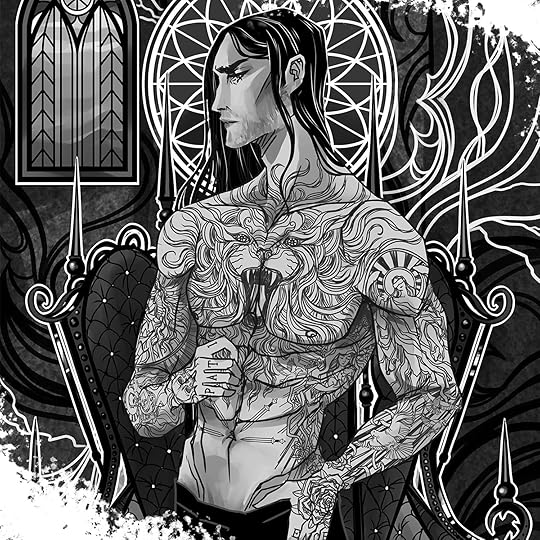
As he ages, I read de Leon as being reminiscent of Geralt of Rivia from Sapkowski’s The Witcher Saga. He comes across as a reluctant hero at certain points, a legendary warrior and swordsman that possesses some magical abilities, with acts of bravery or heroism normally following a sigh or a “for-fuck’s-sake” grunt. At least that’s how I envisaged him.
“I am the boy’s master. He’s impatient. Arrogant. Far too keen for glory. But he’s one of the finest swords I’ve trained, and he took down this highblood alone, drugged to the eyeballs on rêvre. If what I suspect of his line is true… he could be the greatest of us, Talon.” “Or the most terrible.”
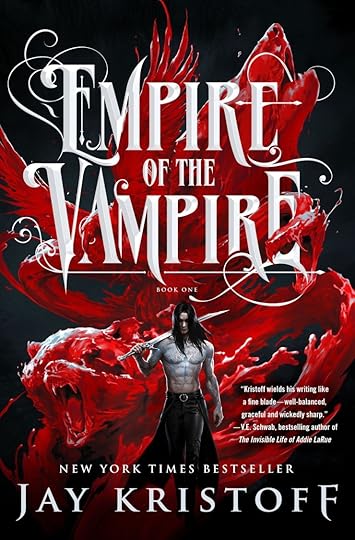 Although this is Gabriel de Leon’s tale, he shares the page-time and has interesting relationships with a whole range of intriguing characters. Favourites for me were the rival Aaron de Coste, the master Greyhand, the enigma Dior, and the Holy Sister Astrid. He also has a slightly unhinged talking blade called Ashdrinker. The members of the Forever King’s family whose paths cross with Gabriel’s in Empire of the Vampire make for fine antagonists, being imposing, beautiful, ageless, and terrifying. A part that I really enjoyed and applaud Kristoff for the way he presented this, was when a character we were familiar with from de Leon’s youth returns to the page over a decade and a half later in the other timeline. This brought a few true smiles to my face.
Although this is Gabriel de Leon’s tale, he shares the page-time and has interesting relationships with a whole range of intriguing characters. Favourites for me were the rival Aaron de Coste, the master Greyhand, the enigma Dior, and the Holy Sister Astrid. He also has a slightly unhinged talking blade called Ashdrinker. The members of the Forever King’s family whose paths cross with Gabriel’s in Empire of the Vampire make for fine antagonists, being imposing, beautiful, ageless, and terrifying. A part that I really enjoyed and applaud Kristoff for the way he presented this, was when a character we were familiar with from de Leon’s youth returns to the page over a decade and a half later in the other timeline. This brought a few true smiles to my face.
There is a lot to enjoy here in Kristoff’s horror-tinged, vampire-laden, epic fantasy tale. In fact, it was the most I’ve enjoyed a fantasy novel for a long time. I thought it was very well written, being descriptive enough for my mind to fill in the blanks, crafting some impeccable imagery, and adrenaline-fuelling grand set-pieces. Occasionally dancing on the line of melodramatic, but for me personally, it stayed on the right side, being more cinematic than needlessly extravagant. Empire of the Vampire is packed with many stand-out scenes, and knowing that this is only a portion of de Leon’s legendary tale, I’ll be picking up a copy of the sequel as soon as I can. 9/10.
Final Note: The internal artwork by Bon Orthwick (@monolimeart) is incredible, an example of which can be seen above and was copied from the book’s Amazon UK page.
Read Empire of the Vampire by Jay Kristoff
The post REVIEW: Empire of the Vampire by Jay Kristoff appeared first on Grimdark Magazine.
September 5, 2021
REVIEW: Hammer and Bolter: Death’s Hand
In Deaths Hand, the first episode of Hanmer and Bolter released on the new Warhammer+ platform, Inquisitor Kiamoro’s death has been foretold, and he’ll do just about anything to stop it. He’ll kill sanctioned psychers, consort with aliens, and sacrifice just about anything. With internment on Terra his reward for two centuries of service to the Throne within arms reach, can he make it?
Animated in a manga style, Death’s Hand is a complete and brilliant short story (I’m assuming the Hammer and Bolter series will be a new story each release, unlike the Angels of Death or Astartes animated series also showcased on Warhammer+). The manga style is certainly not my visual preference, but hats off to the team for writing an excellent and fun story to create from. It’s fun, punchy, has good twists, and from that very first scene I just knew I was going to enjoy it.
Without a focus on space marines or the Guard, there’s a lot to unpack here from a factions perspective, and the nature of Inquisitors who get a fair bit of grey areas, comparatively, gives the creators plenty to play with. If you enjoyed Eisenhorn by Dan Abnett, then I think you’ll enjoy this.
Death’s Hand is a thoroughly enjoyable start to the Hammer and Bolter series and one I’m sure most 40k fans will enjoy. Starting off Warhammer+ with a space marine and an inquisitor series was an excellent decision—and here’s hoping the next episode is just as good as the first.
Watch Hammer and Bolter: Death’s HandThe post REVIEW: Hammer and Bolter: Death’s Hand appeared first on Grimdark Magazine.
September 4, 2021
REVIEW: Blindsight by Peter Watt
Originally published in 2006, Peter Watt’s Blindsight tells the story of what happens when 65,000 alien probes flashed simultaneously, instantaneously surveying the earth. When a probe of our own intercepts an extraterrestrial signal of unknown origin and receipt shortly thereafter, a team is sent to investigate, and possibly make first contact. Naturally, nothing good happens!
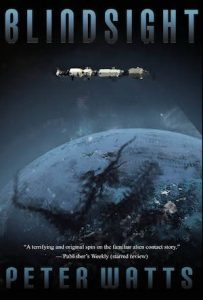 Blindsight is densely packed with themes and concepts relating to consciousness and sentience (amongst other things) that made me want to put the book down and really think about what Watts was trying to say. Sometimes there was too much going on thematically – it felt like Watts was trying to cram 50 pounds of philosophy into a 30-pound bag. Many of these themes are explored through dialogue and exposition, which to Watts’ credit works well. While it’s clear he’s using the voices of the characters to deliver his philosophy, it doesn’t come across as forced or pedantic. Occasionally though Watts would touch on a subject and then move on without exploring it, which could be frustrating and a little disjointed. Likewise, characters would have a-ha moments that I as the reader didn’t share, leaving me to just shrug and move along.
Blindsight is densely packed with themes and concepts relating to consciousness and sentience (amongst other things) that made me want to put the book down and really think about what Watts was trying to say. Sometimes there was too much going on thematically – it felt like Watts was trying to cram 50 pounds of philosophy into a 30-pound bag. Many of these themes are explored through dialogue and exposition, which to Watts’ credit works well. While it’s clear he’s using the voices of the characters to deliver his philosophy, it doesn’t come across as forced or pedantic. Occasionally though Watts would touch on a subject and then move on without exploring it, which could be frustrating and a little disjointed. Likewise, characters would have a-ha moments that I as the reader didn’t share, leaving me to just shrug and move along.
Characterization is both a strength and a weakness here. As a child half of protagonist Siri Keaton’s brain was removed to treat chronic epilepsy. What was left was someone who could glean a world of information from a person’s smallest gesture but was unable to experience true feelings or emotions. Commanded by a vampire, Siri is joined by a linguist whose brain has been constructed to house multiple personalities; a biologist who can interface with his equipment cybernetically; and a soldier who can command a horde of killer drones. The characters were rich and lifelike, with actual personalities that go beyond describing their roles on the team. Only a few of the characters’ backstories are addressed though, and that felt like a missed opportunity.
But at the same time, Blindsight is a real page turner. Throughout, Watts does an excellent job of ratcheting up the tension, making you feel wonderfully uncomfortable. Just when you think you have a grip on what’s going on, he adds a twist that keeps things from being predictable or cliched. Blindsight has a very rewarding loop of presenting a mystery, then solving that mystery with an even more terrifying one. By the conclusion, there were questions left unanswered that left me thinking about the story for days after.
Overall, I enjoyed Blindsight. I recommend it, especially if you are a fan of darker science fiction along the lines of Aliens or Even Horizon. As of this writing (August 26, 2021), the full novel was available for free from the author’s website: https://rifters.com/real/Blindsight.htm
Read Blindsight by Peter Watt
The post REVIEW: Blindsight by Peter Watt appeared first on Grimdark Magazine.
September 3, 2021
REVIEW: Summer Sons by Lee Mandelo
Summer Sons by Lee Mandelo is one of those delicious books that coast by on vibes more than anything else. Set in Appalachia, this is a story of love and loss, of mystery and ghosts haunting your past and present. Andrew is a young man in his early twenties, moving to join his best friend and adoptive brother Eddie at graduate school in Nashville, Tennessee. Except, Eddie’s dead. And Andrew has no clue what happened to him – although he is certain that it wasn’t the suicide everyone seems to believe it was.
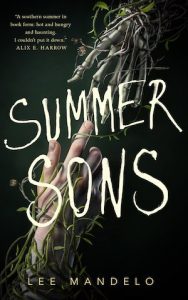 Joined by a cinnamon roll of a housemate, Riley, whom he inherited from Eddie along with his house and research project, Andrew is drawn into a world of dark academia, drug dealing hotties (why yes, Andrew is very much a heterosexual man, why would you ask?) and strange happenings.
Joined by a cinnamon roll of a housemate, Riley, whom he inherited from Eddie along with his house and research project, Andrew is drawn into a world of dark academia, drug dealing hotties (why yes, Andrew is very much a heterosexual man, why would you ask?) and strange happenings.
I devoured this wonderful book in just a few sittings and couldn’t get enough of this dark and addictive worldbuilding and the fantastically written characters. The tension between Andrew and Riley’s cousin Sam and their constant will-they-won’t-they while Andrew comes to terms with his own sexuality is electrifying and honestly one of the best romantic arcs I’ve ever read when it comes to chemistry. And this kind of strong writing and characterization is what makes Summer Sons shine. Add in a university setting, a mystery and ghost stories on top of uncanny events in Andrew’s life and you have a recipe for success.
My only slight gripe with the book was that I guessed some aspects of the resolution too early, which made the ending too transparent for my taste. But then, I’m probably a more avid and attentive reader than most, and ultimately, it didn’t take away from my enjoyment of the book as a whole – the book is stronger in its vibes than in its plot.
An element that stood out to me as very strong was its treatment of trauma and mental health issues. Not only did the characters all deal with grief and trauma over Eddie’s death in their own ways over the course of the story, but the book ended with a rather incisive event which affects the main characters in different ways and significantly impacts their relationships with each other. This isn’t just glossed over in the quest for a happy ending, but even in the small amount of time remaining dealt with in a healthy and realistic way to give a satisfying conclusion to both characters and readers.
As you can probably tell, I absolutely loved Summer Sons and highly recommend it. I especially think that this is well suited for those of you who enjoyed Ninth House by Leigh Bardugo or A Lesson in Vengeance by Victoria Lee.
Read Summer Sons by Lee Mandelo
The post REVIEW: Summer Sons by Lee Mandelo appeared first on Grimdark Magazine.
September 2, 2021
REVIEW: There Is No Antimemetics Division
The SCP Foundation is a collaborative setting that anyone can add to. It stands for Secure, Contain, and Protect, and deals with a specialized bureaucracy dealing with things that don’t make sense in our reality: monsters, artifacts, modern objects that have been warped or turned paranormal in some way.
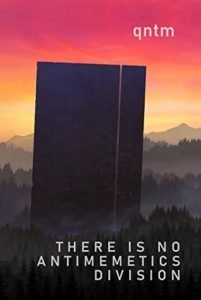 Most of the SCP stories take the form of in-world documents, listing the object or creature by designation, and then explaining what it does and what sort of precautions work to keep people safe from it. This sort of detached, scientific analysis of horrific, reality-altering creatures and objects works fantastically to create a specific tone, a mix of dark humour and cosmic horror.
Most of the SCP stories take the form of in-world documents, listing the object or creature by designation, and then explaining what it does and what sort of precautions work to keep people safe from it. This sort of detached, scientific analysis of horrific, reality-altering creatures and objects works fantastically to create a specific tone, a mix of dark humour and cosmic horror.
The SCP stories started in 2008 and have continued since. There are over 6,000 SCP classification stories, and thousands more ‘Foundation tales’ that are written in a more typical short story style. They’ve made their own video games, and clearly inspired Remedy’s 2019 game Control. While I’ve only read these occasionally, my favorite of them is a recording of a basketball game in which the people who were recorded gain more self-awareness the more times the recording is replayed. (It’s available here: https://scp-wiki.wikidot.com/scp-1733 )
All of that brings us to qntm (real name Sam Hughes)’s SCP book There Is No Antimemetics Division.
This story employs a mix of the SCP classification and the more traditional style of Foundation Tales. I appreciate qntm’s desire to write a story that swings for the fences in its very premise. I’m not even sure whether I should call it a novel or a short story collection as many chapters felt like distinct entities but worked together to create a whole.
The opening section of There Is No Antimemetics Division was excellent. It consistently hit the place I love in science fiction and fantasy, where reality almost but doesn’t quite make sense. That frisson between the real and the unreal is my favorite thing about speculative fiction.
There is No Antimemetics Division follows Marion Wheeler, the head of the Antimemetics Division. No one else in Site 41 remembers her, or the rest of her division, because that’s how antimemetics work—they ruin people’s memories. With enough capability, they can make it so no one else remembers them. The title is a direct quote from Marion Wheeler’s boss at Site 41, who forgot she existed—as well as her entire department.
There was a section near the beginning where one of the staff who worked under Wheeler was lost to these antimimetic creatures, to the point that everyone else’s eyes would simply pass right over him as if he didn’t exist. Worse, by stealing his memories they essentially ate any plan he could come up with. It was eerie by itself, but then he found a list, written by other people this had happened to, of what they had tried to do to stop these things, and how every one of the attempts had failed.
The most common countermeasures to the antimemetics are mnestics—drugs that enhance memory and counteract antimemetics, and amnestics—drugs that do the opposite, and make people forget. Wheeler also uses trivia to distract them. They also have plans for developing countermemes but it will take years, and if the entities eat any memories associated with the plan in the interim, they’ll know all about it.
The characters in this book are quick sketches rather than fleshed out and fully realized, but I don’t find that a problem. This book knew what it wanted to be, and deep characterization wasn’t part of that. It has big ideas it wants to examine instead. A few of the slower chapters entail the marriage of Marion Wheeler and her husband Adam, a violinist, and I will admit I enjoyed those. But they weren’t the selling point of this novel.
There Is No Antimemetics Division hit one particular wall that kept it from being a five-star book. The last act became too big, too fast. The opening sections had tense paranoia, but the ending felt rushed and the stakes ceased being personal.
That said, I’d rather a flawed book that does something new than a book that plays it safe. The idea of entities that can not just eat your memories, but by doing so, make people forget they knew you, hits both my enjoyment of cosmic horror and stories that play with memory. There Is No Antimemetics Division managed a paranoid unreality that I truly loved.
Read There Is No Antimemetics Division
The post REVIEW: There Is No Antimemetics Division appeared first on Grimdark Magazine.
The Wheel of Time Trailer is here!
The Wheel of Time is not a grimdark series by even loose standards but it is one of the seminal works of fantasy from the Nineties. It takes many classic tropes of fantasy: the farm boy, the Chosen One, a magical teacher, prophecy, and a war between Good vs. Evil at its most primal then puts its own spin on it. Robert Jordan was a powerful influence on me during my high school and college years to the point that even when my tastes evolved, I always held The Wheel of Time in high esteem.
The Amazon series is something that a lot of us were interested in but I admittedly had some skepticism, even with Game of Thrones showing that you could theoretically adapt 70% of a series faithfully on screen. I was even more impressed with the Netflix adaptation of the first two Witcher books. Unfortunately, we have The Shanarra Chronicles to show how things can also go terribly wrong. Still, I was a first day viewer of the trailer for the series and am happy to share my thoughts.
The Wheel of Time trailer has a strong focus on the witches (Aes Sedai) of the series with Moiraine (played by Rosamund Pike), Nynaeve (played by Zoe Robins), and Egwene (Madeleine Madden). The special effects for the use of magic seem serviceable if not necessarily hugely impressive. We see arrows being stopped midair, wind magic, and some other displays that put me in mind of Avatar: The Last Airbender. It seems mostly consistent with the female power as described in Jordan’s books. I’m a huge Rosamund Pike fan and what little we see of the other two seems to do some classic scenes from the book.
We get glimpses of Emond’s Field and since this is where the first third of The Eye of the World takes place, getting this right is important. Unsurprisingly, it does have a little bit of a Shire feel to it despite everyone being tall burly folk. We don’t see much of Rand, Perrin, or Mat but the few scenes we do are ones that make it seem like they have the characters down. Mat is a laughing rogue, Perrin is reserved, and Rand sort of falls in the middle.
The Wheel of Time trailer provides a glimpse of the Aes Sedai and their political machinations that provide an important undercurrent to the series, everyone looking mostly appropriate. Above the Warcraft movie below Lord of the Rings level, IMHO. I was genuinely impressed with the city of Tar Valon and the Shadowspawn. Both seem like they come from much bigger budget movies and will be fun to see onscreen.
The trailer leaves me cautiously optimistic. The special effects do come off as a bit low-rent Lord of the Rings but it does feel like it has a strong grasp of the material. I can’t wait to see an episode of The Wheel of Time on screen.
The post The Wheel of Time Trailer is here! appeared first on Grimdark Magazine.
September 1, 2021
REVIEW: Angels of Death: Blood and Duty
First cab off the rank for the new Warhammer+ is Angels of Death episode 1, Blood and Duty. For somebody who has long fallen out of love with the actual tabletop game, but still can’t get enough of the books and animations like Astartes, when I saw the Warhammer+ announcement I was so happy. Games Workshop seeing animator creators making money from their IP through Patreon and YouTube and the like was only going to end one of two ways—take down notice or employment. I’m glad that for most that this is where we land. Fan creators are getting employed and not sued.
In Blood and Duty a space marine Blood Angels captain is missing, lost on a planet covered by electrical storms and facing off against the endless horde of the Tyranids. Aboard a battle cruiser in orbit, Sergeant ??? must push his brothers to make a run to the surface to save their leader. However there’s only 11 of the full 100 compliment of the company left alive, and the geneseed taken from slain brothers to create new space marines would be left all but unguarded should they drop to the surface to attempt rescue.
Beautifully animated in greyscale except for the red of armour and helmet lenses, Blood and Duty is a visually stunning introduction to the Warhammer+ content. The approach conveys darkness and grit so well, and with the animators working overtime on the gothic glory of the scenery, Blood and Duty is gloriously presented. I watched a review of Warhammer+ opening 48hrs and the YouTuber mentioned being off put by the mouth movement animation. Honestly, it didn’t bother me—we’re watching a stylistic animation, not a human.
Blood and Duty presents a simple story so far, with a clear direction for following episodes, some external conflict and some internal conflict amongst the marines. It has all of the great building blocks of an excellent animated series, and alongside the eagerly anticipated Astartes Season 2, shows that Games Workshop are here to deliver top quality content through Warhammer+
Watch Angels of Death: Blood and Duty on Warhammer+The post REVIEW: Angels of Death: Blood and Duty appeared first on Grimdark Magazine.
August 31, 2021
REVIEW: Half a King by Joe Abercrombie
Half a King has been touted by some outlets as Abercrombie’s foray in to the realm of the ‘young adult’ fantasy novel but do not let the age of our protagonist fool you. This is not a children’s story. It is as dark and brutal as one might expect from Abercrombie and, although slightly shorter than some of his other offerings, it is still a respectable length at just shy of 400 pages in length.
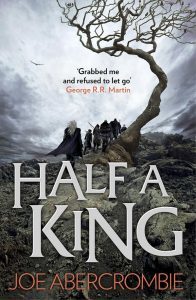 This first novel in the Shattered Sea trilogy tells the journey of the cunning young Yarvi and his mission for vengeance along with the reclamation of the Black Chair of Gettenland after a trail of murders and usurpers. The throne is one Yarvi did not want nor expected to sit on as the younger son of a legendary King with a malformed hand making him a poor warrior and weak in the eyes of his countrymen. Instead Yarvi had been destined for a life as a member of the kinless Ministry, acting as a healer, archivist, and advisor to the Ruler.
This first novel in the Shattered Sea trilogy tells the journey of the cunning young Yarvi and his mission for vengeance along with the reclamation of the Black Chair of Gettenland after a trail of murders and usurpers. The throne is one Yarvi did not want nor expected to sit on as the younger son of a legendary King with a malformed hand making him a poor warrior and weak in the eyes of his countrymen. Instead Yarvi had been destined for a life as a member of the kinless Ministry, acting as a healer, archivist, and advisor to the Ruler.
Every one of Yarvi’s sharp wits are tested in the mission to regain his throne. On his journey we meet a range of other characters and are never completely sure of their true purpose. Some help, some hinder, and some form part of an unforeseen bond of friendship like which Yarvi has never felt before.
The lands of this world have a distinct Scandinavian feel and parts of the novel do have a sense of the marauding Viking to them. However there is a comforting familiarity to general premise of a medieval dystopia where the sword seems to rule a bleak and bloody world. The narrative simmers and thickens in a delightful way and mostly short chapters mean it can be read at a relatively fast pace. The world building is less dense and complex than other Abercrombie works which adds to the feeling that this is a quick read, but it is still fleshed out enough to be engaging. There are subtle clues sprinkled throughout pointing to its ending but the main plot twists are unpredictable. The action scenes are bloody and most of the characters well developed. Yarvi himself displayed the moral ambiguity that even at the end of the novel left me unsure if I was rooting for him or not.
Half a King is everything I want from a Joe Abercrombie novel. It is gripping and fast paced from the outset, with a maze of twists and turns that keep you enthralled from cover to cover.
Read Half a King by Joe Abercrombie
The post REVIEW: Half a King by Joe Abercrombie appeared first on Grimdark Magazine.
An interview with S.C. Jensen
We’re lucky enough to have an interview with S.C. Jensen, author of the popular indie cyberpunk series Bubbles in Space. She’s agreed to sit down with us and explain some of the things that went into her writing process.
 [GdM] Could you describe what Bubbles in Space is about?
[GdM] Could you describe what Bubbles in Space is about?
Bubbles in Space started off as an irreverent cyberpunk love letter to my favourite noir writers, Raymond Chandler and Dashiell Hammett. It’s about an ex-drinking ex-cop with a cybernetic arm, a semi-legal P.I. license, and a knack for getting herself into trouble.
I meant for it to be a lighthearted, fun, “fluffy” sci-fi series to kind of purge my system after I finished writing a much darker, dystopian sci-fi trilogy… But it turns out I can’t really write fun and fluffy.
Bubbles in Space is a grit and glitter sandwich with a side of off-the-wall cynicism. It starts off fun and quirky and gets a bit darker the deeper into the series we get.
I do still think it’s pretty fun and funny for the right kind of reader: sci-fi lovers who don’t take themselves too seriously, noir lovers looking for something a little different, weirdos with a twisted sense of humour. People like me, basically.
[GdM] What is Bubbles Marlowe like?
Bubbles Marlowe is a bit of a screw up. She’s newly sober, trying to figure out who she is and where she fits in the world. While she’s solving mysteries and trying not to get killed, she’s also repairing broken relationships and attempting to prove her self-worth. She’s fiercely protective of her friends and believes that everyone is worth saving. But she’s the queen of doing the wrong thing for the right reasons.
Bubbles’ character is based on my own experience with alcohol addiction and the rollercoaster to recovery. I really wanted her to reflect what it’s like to have to re-discover who you are in your mid-30s when a major part of your adult identity has been stripped away. I hope others in recovery will see their own struggles reflected in the ups and downs of her character arc. Especially the ups!
This might be a bit of a spoiler, but I think it’s important to mention for those who are in recovery: I will not be using relapse as a plot twist. Bubbles is sober and she will stay sober for the entire series. Her character arc is about recovery.
 [GdM] What’s her situation at the start of Tropical Punch?
[GdM] What’s her situation at the start of Tropical Punch?
Bubbles is having a rough go of it. The Chief of Police wants her dead, she’s got no money, she’s been warned off a case by her ex-partner. And when she takes what should be a straightforward job delivering a message to an exotic dancer, heads literally roll. No matter what she does, Bubbles seems to make things worse. So she decides she needs to get out of town. Of course, that goes about as well as you’d expect!
[GdM] What attracted you to the cyberpunk genre?
Cyberpunk embodies all of my favourite themes in writing. Before I was really cognizant of the genre, I was exploring things like income disparity, classism, life in the underbelly of society. I think this is what drew me, as a reader, to the old noir pulp detective stories.
As technology becomes a greater and greater part of our everyday lives, I am very interested in the ways that it exacerbates these problems, and also the ways that it acts as an equalizer. Cyberpunk is neo-noir in essence, and that’s what really attracted me to the genre. I love the aesthetic dichotomies of cyberpunk, too. Darkness and light, metal and flesh, human and machine. It’s got so much potential!
[GdM] How would you describe HoloCity?
HoloCity is the quintessential western cyberpunk city. It’s a sprawling megacity controlled by powerful corporations and economic interests, world governments have been replaced by Trade Zones, politicians and law enforcement are bought and paid for so no one ever really knows where anyone’s loyalties lie. It’s capitalism on steroids, basically. This creates some challenges for our underprivileged protagonists, but it creates opportunities too.
 [GdM] Who is your favorite character after Bubbles?
[GdM] Who is your favorite character after Bubbles?
I love them all! That’s a tough question…
I see Hammett, her sobriety support pet (an electronic pig) as a kind of extension of Bubbles so I can’t choose it. I think it’s a toss up between Dickie Roh, Bubbles’ pulp noir fan boy partner at the detective agency, and Cosmo Régale, the lusty gender bending fashion magnate. They are both comic relief type characters and act as a balance against some of the darker themes at work in the series, but they serve as important supports to Bubbles’ development in their own ways.
[GdM] Why does cyberpunk work so well with noir detective stories?
I started to get into this a little earlier. I think cyberpunk is really a kind of neo-noir. It’s exploring the same themes as 1930s-1950s noir detective novels—morality in a corrupt society, the criminal underbelly of wealth and prosperity. Noir detectives tended to be underdogs, outsiders to the wealthy worlds of their clients, and they often uncovered the hidden seediness of upper-class lives. Pulp noir was an exploration of ethics, and a deconstruction of the idea that money equals human worth.
Cyberpunk does all of this, too, and it expands on it.
Cyberpunk goes beyond considering morality in a corrupt world. It asks not only what it means to be “good” but explores what it means to be human. Then it deconstructs the idea that to be human is to be good.
I think that’s the power of a film adaptation like Blade Runner from Do Androids Dream of Electric Sheep?
The ethics of transhumanism are a much bigger and more complex issue today than the morality of the 1930s, but thematically they are similar. Both questions are rooted in our need to classify this as “good” and “bad.” Both genres force us to question whether there is such a thing as good and bad in a corrupt world.
[GdM] How has the response been to the Bubbles series?
Bubbles in Space is a bit of an odd-ball genre mash-up so it has been difficult to find the right readers. Some people don’t really “get it,” and that’s okay. I knew that was a risk when I started it.
I’m frankly not very good at writing to market, and I probably never will be. That’s both a blessing and a curse. Bubbles might never be a mainstream best-seller (that wouldn’t be very cyberpunk anyway) but she’s got a strong, loyal following which is a dream come true for me.
Overall, the response to Bubbles in Space has been overwhelmingly positive. I am thrilled and humbled to be finding my little group of weirdo book nerds who do “get it” and love the series as much as I do!
One of the best things about being a niche writer is that I have a very strong relationship with my readers. I’m able to respond to emails and messages personally and get to know the people who reach out. This, more than anything, makes me feel like Bubbles has been a huge success!
[GdM] Do you have any advice for indie authors?
My best advice for other indie writers is, no matter what, just keep writing. Get your work out there. Most “overnight” successes are many years in the making. You don’t have to have a run-away hit to make a living as a writer so don’t let “perfection” get in the way of progress. This is a long game!
I recommend joining a professional group and surrounding yourself with other people in the business. I love the Facebook group 20BooksTo50K® and would love to see you there!
 [GdM] What can we expect from you now?
[GdM] What can we expect from you now?
Books, books, and more books!
I plan to have the last two books in Bubbles in Space out before the end of 2021. I also have a series of standalone novellas, called Holocity Case Files, for those who want a glimpse into Bubbles’ first cases. The first one, Dames For Hire, is available for free to those who join my VIP Readers Club, or you can buy it on Amazon for $0.99. I’m hoping to have the next couple out early next year.
I will be expanding on the HoloCity world with a techno-thriller series, too!
I am re-releasing my first novel, The Timekeepers’ War, as well as the 2-4 other books in that series in 2022 as well. My original publisher sadly passed away this year before the release of the second book, so I am waiting for copyright to revert to me and I will be publishing the series independently.
This is a dark science fantasy series set in the same story universe as Bubbles in Space, but not directly connected (yet). Fans of the dystopian/post-apocalyptic genres who are looking for something a little different will love this series!
If you haven’t read The Timekeepers’ War yet and are interested in the series, I ask that you please wait to buy the second edition. The first edition is tied up with my publisher’s estate and I don’t know yet if I will see the royalties from those sales while the book is in limbo. Thank you for your patience. You can join my mailing list for updates!
Read Bubbles in Space: Tropical Punch by S.C. Jensen
The post An interview with S.C. Jensen appeared first on Grimdark Magazine.
August 29, 2021
REVIEW: When Things Get Dark edited by Ellen Datlow
When Things Get Dark is a new anthology edited by Ellen Datlow. Datlow is a well-respected anthologist, who has won plenty of awards, including the Shirley Jackson Award three times. This made her the perfect choice for this anthology, which is intended to be inspired by Shirley Jackson and her work.
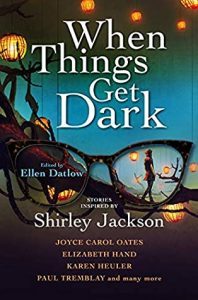 Shirley Jackson was the author of numerous books, but she’s most famous for her short story, “The Lottery,” and The Haunting of Hill House. She also wrote We Have Always Lived in the Castle, and the memoir Life Among the Savages. Her work is horror, but a very specific form, a low-key unease that gets under one’s skin rather than more direct chills.
Shirley Jackson was the author of numerous books, but she’s most famous for her short story, “The Lottery,” and The Haunting of Hill House. She also wrote We Have Always Lived in the Castle, and the memoir Life Among the Savages. Her work is horror, but a very specific form, a low-key unease that gets under one’s skin rather than more direct chills.
Jackson’s work tended to center women, and those who didn’t fit in with society. Her writing was often scathing towards society (The Lottery is the most obvious, but also clearly the case in We Have Always Lived in the Castle), but there was also a longing in it for that connection, and a perpetual disappointment whenever it was made. Those are the kinds of stories in When Things Get Dark.
A collection like When Things Get Dark is guaranteed to have a few obstacles. A few of the stories felt like they aped Jackson without bringing in much of their own. One felt like a slow-burn opening and then ended quite suddenly. But the stories that work, work well.
Elizabeth Hand’s For Sale By Owner had a solid grasp on the low-key quality of both horror and humour that infused Jackson’s work. As a youth, a woman used to break into houses, not to steal but just for the thrill of it. As an older woman, she takes up the pastime again and gets a couple other older ladies to join her until they decide to camp out overnight in a long-abandoned but remarkably upkept house. This was far from the scariest story in the book, but it was a joy to read and definitely felt inspired by Jackson.
Benjamin Percy’s Hag took the uncomfortable family elements of Jackson’s work. A journalist and a mother is trying to get a story done before Christmas. She takes the ferry to the island, and discovers her daughter has stowed away with her. The resentment she feels at having to take care of her daughter while working is strong, though not overstated. Strange occurrences happen through the island they’re on as they wait to get back to the mainland, including one scene that was the most vivid moment in the entire collection.
Stephen Graham Jones’ story, Refinery Road, was a great gut-punch of a story. A young man is driving his friends around, trying to get one friend’s mind off her troubles. The violence that erupts is out of nowhere, and impossible, which makes it all the more compelling. There’s no ghost or monster hunting them. As a side note, Stephen Graham Jones also wrote my favorite book of last year, The Only Good Indians.
Kelly Link’s story, Skinder’s Veil, was the strongest in the collection. It used Jackson as inspiration, while very much being a Kelly Link story. It followed a grad student, having difficulties with writing his dissertation and being frustrated by his roommate. He agrees to house-sit a small secluded cabin owned by a man named Skinder, where he’s given two very specific instructions—let in any of Skinder’s friends, and never, no matter what, let in Skinder.
It’s impressive that a book that is to celebrate one woman, whose own work was genre-defining but had a very specific mindset, could offer up such a wide variety. It’ll be coming out just in time for Halloween, so if you’d like a bevy of very different horror stories for the season, I’d definitely recommend it.
Read When Things Get Dark edited by Ellen Datlow
The post REVIEW: When Things Get Dark edited by Ellen Datlow appeared first on Grimdark Magazine.




